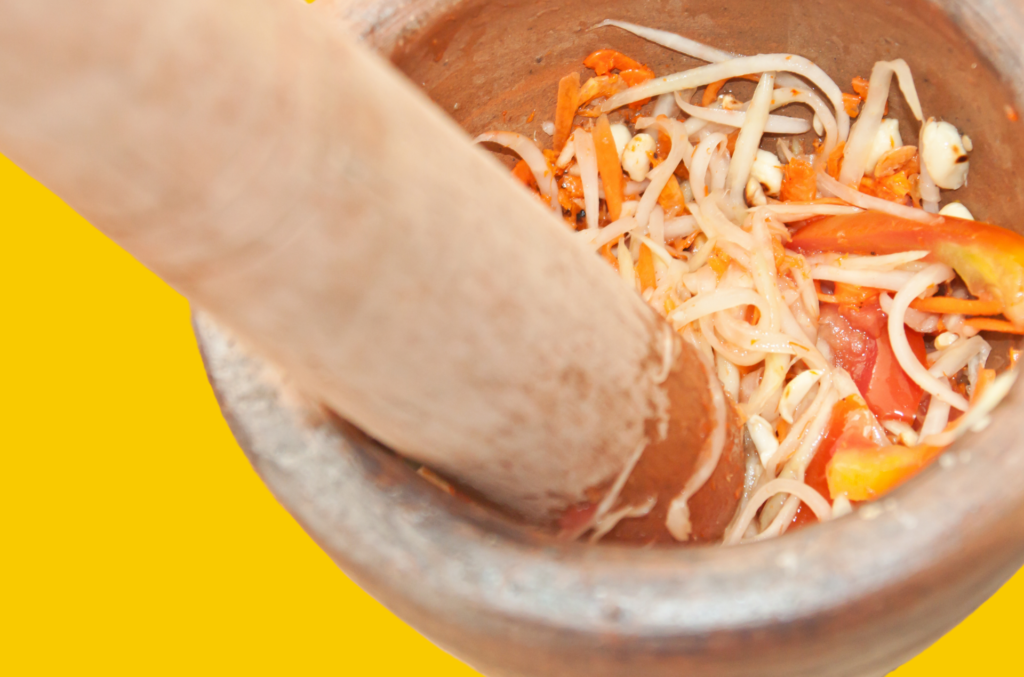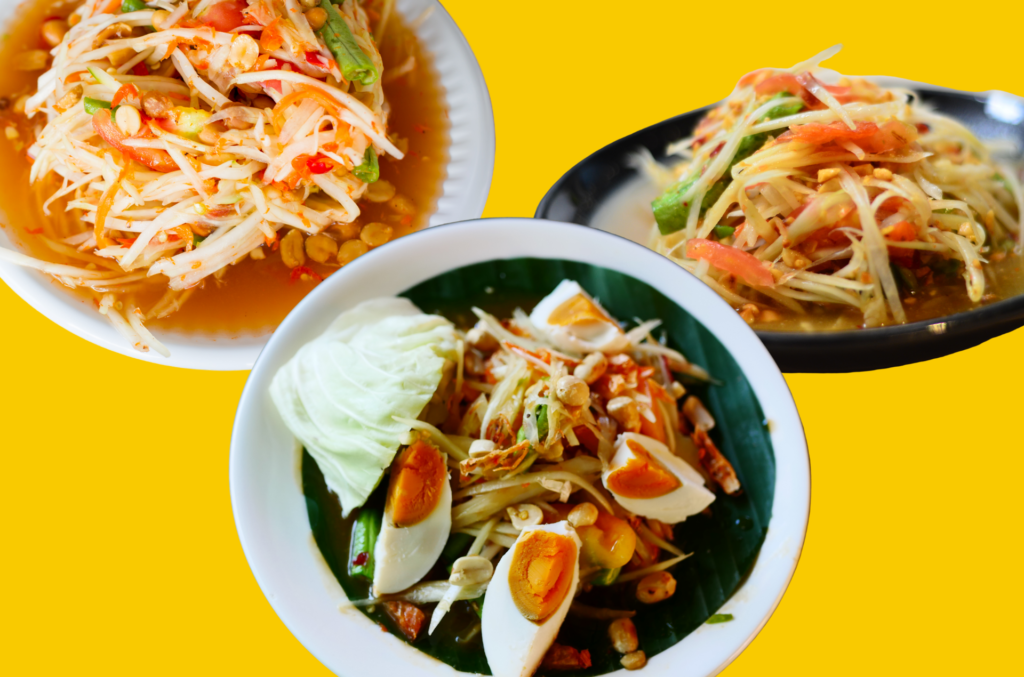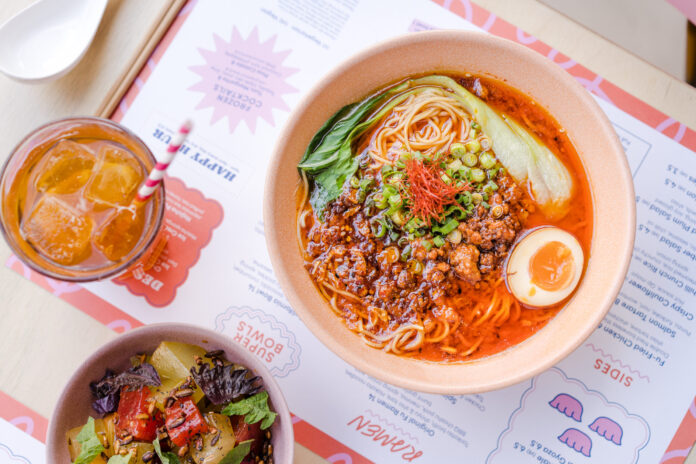Som Tam is one of the stalwarts of Thai cuisine and is consistently named as the world’s greatest salad by those who know. Consumed all over the country in different forms, guises and levels of pungency, at its heart Som Tam is a pounded (to order) salad of vegetables and fruit, with a salty, spicy, and always assertive dressing.
Though many versions further North East and onwards to Laos (called ‘Tam Mak Hoong’, and arguably where this great salad originated) have a more pungent bent, the ‘Bangkok’ or ‘Thai’ version throws sweet and sharp into the dressing mix, and it’s this rendition which we’re making today. Combined with some grilled meat and freshly steamed sticky rice, this salad makes up one of the finest meals you can have on the planet. No wonder it’s referred to as the ‘Holy Trinity’ in Thailand.
Anyway, if you’re looking to recreate Som Tam at home, you’re in luck; it’s actually quite simple to do. Here’s how to make the IDEAL Bangkok style Som Tam.
THE TOOLS
The assemble this salad the key piece of equipment you’re going to need is a large terracota pestle and mortar with a deep, conical bowl and wooden pestle. You’re not making a curry paste or pesto here, and won’t be pounding ingredients into oblivion, so if you don’t own a Som Tam specific pestle and mortar (sometimes referred to as a ‘pok pok’; onomatopoeic for the sound of pounding) then a large mixing bowl and rolling pin is your next best bet.

LOOK BEYOND PAPAYA
Shredded unripe green papaya is the most commonly used body of this dish, but it’s by no means the only vehicle used. As long as you’ve got a crunchy fruit or vegetable able to take on some dressing, you’re good. The name ‘Som Tam’ simply refers to the sourness of the dish, ‘som’, and the muddling method of mixing and making it, ‘tam’.
Should you be using papaya for your Bangkok style Som Tam, be warned that it’s around £7 for just one in the UK, and usually only available in specialist Asian supermarkets. And you’ll also need a dedicated papaya shredder, which looks similar to a handheld potato peeler, but with grooves to shred single strands.
That, or you could use the hair raising method seen in Thai markets across the country; simply grip the peeled green papaya in your hand, lengthways, so the bottom rests on your wrist. Then, with a sharp knife, make lots of indentations, lengthways again, in the fruit, before finally slicing downwards and away from you to get shredded, non-uniform pieces. Though this method elicits the best pieces of papaya for eating, you might chop off your hand in the process.
The good news it that you neither have to part with lots of cash or a limb to make a great Som Tam at home. In Thailand, Laos and beyond, vendors make this amazing salad with all manner of different fruits and vegetables. Just a couple of our favourites include Som Tam Polamai, which is made with fresh seasonal fruit, such as strawberries, peaches and apple, or Som Tam Taeng Kwa, a pounded salad of cucumber chunks.
In the UK, shredded carrots or pieces of sweetcorn are also an ideal addition. Many Som Tams in Thailand include snake beans, which you can replicate with raw green beans fairly accurately. Put simply, most fruit or vegetable which can be cut into bite sized pieces and pounded to take on the flavours of a dressing are fair game.

DEEP FRIED ELEMENTS…
If you’re wondering how to make the IDEAL Bangkok Som Tam, then the definitive ‘Thai’ version usually includes deep fried peanuts and deep fried dried shrimp. Both these bring a richness which complements the tart dressing beautifully. We’d implore you to seek out dried shrimp in your local Asian supermarket to replicate this alchemy.
To prepare the dried shrimp for deep frying, soak a handful in warm water for a few minutes, then scrupulously dry with paper towel. Heat some vegetable oil in a pan until hot (160°C is about right) then deep fry the dried shrimp until golden and crisp; around 2 minutes. Drain on the paper towel and repeat the process with a handful of roasted peanuts (not salted or redskin).
…& WATERY ELEMENTS
The best Bangkok Som Tams usually also contain tomato, not as the defining component or as the one which gives the version its name, but as a supporting actor which gives the dish a little more liquid as its pounded, and a freshness in the final product. As such, you should include some in yours.
Usually, a fairly bland cherry tomato should be prioritised, as its the wateriness of the fruit we’re looking for, rather than the flavour. Simply halve a handful and you’re good to go. That, or chip a few random pieces off a plum tomato, as they tend to do on the streets of Bangkok.
You should also include a few small chunks of lime in your mix, which brings moisture once again and an enjoyable bitterness from the skin.
THE ALL IMPORTANT DRESSING
The Som Tam dressing is what makes or breaks your salad. It needs to be spicy – really spicy – from several pounded red and green bird’s eye (or better yet, prik kee noo) chillis, with a balance of salty, sweet and sour, from fish sauce, palm sugar, lime and tamarind water respectively. To make the latter, you’ll need to buy tamarind pulp from a specialist supermarket, and mix it with hot water before passing through a sieve.

THE METHOD
We’ve come this far. Now, let’s get to it. A Bangkok style Som Tam won’t usually be measured out to the letter in the markets and street stalls of the capital. We’ll do out best to mimic that experience here, but with a recipe of sorts.
You’ll need:
- a dish’s worth of shredded green papaya – around a third of a fruit
(do feel free to replace with shredded carrot or bite-sized pieces of cucumber)
- A handful of deep fried shrimp
- A handful of deep friend peanuts
- A handful of halved cherry tomatoes
- A few pieces of diced lime (around an eighth of a ‘cheeked’ single lime, with no seeds)
- A handful of bite sized (an inch) lengths of snake (or green) beans, raw
For the dressing:
- A couple of peeled garlic cloves
- Several (depending on your spice tolerance) red and green bird’s eye chillis
- A tbsp of fish sauce
- A tbsp of lime juice
- A tbsp of palm sugar
- A tbsp of tamarind water
In your conical pestle and mortar or mixing bowl, pound the garlic and chilli together until it’s a rough paste. The more you pound here, the hotter your Som Tam will turn out.
Add your palm sugar and lime pieces to the vessel and muddle until everything is a sludgy, homogenous unit. Next, add the green beans and bruise slightly, followed by the other dressing elements (your fish sauce, tamarind and lime juice). Mix well and taste; the dressing should be perfectly balanced between sour, salty and sweet, with a little richness from the palm sugar, too. Adjust accordingly.
Next, add your shredded papaya (or carrot and cucumber) and using a largely spoon, lift the dressing mixture and papaya to mix, pounding gently with the pestle to lightly bruise the papaya without destroying its crunch. You still want the salad to stand tall at the end, not collapse, but simultaneously, the papaya should take on the flavour of the dressing. Be fairly gentle, and keep tossing and pounding.
Finally, add the tomatoes, shrimp and peanuts, and aim for these in the mortar the release the juices of the tomato and break up the peanuts slightly. Give the dressing one final taste to see if the balance is right, and alter it should you need to. Pile the finished article onto a plate and give it some height. Enjoy with sticky rice!





